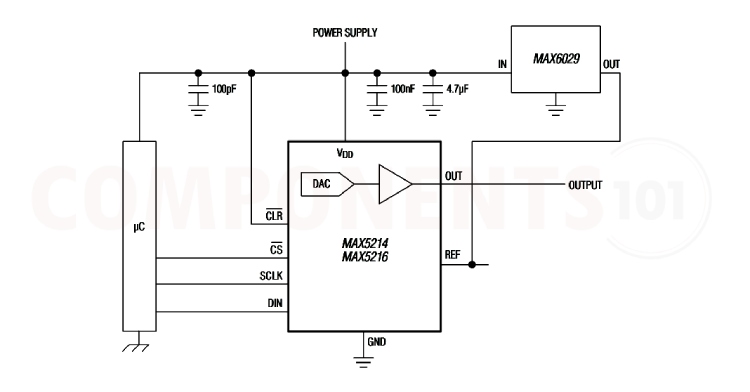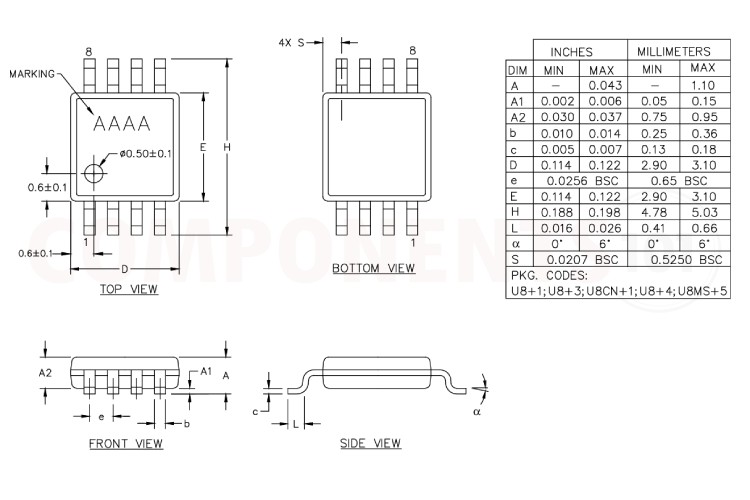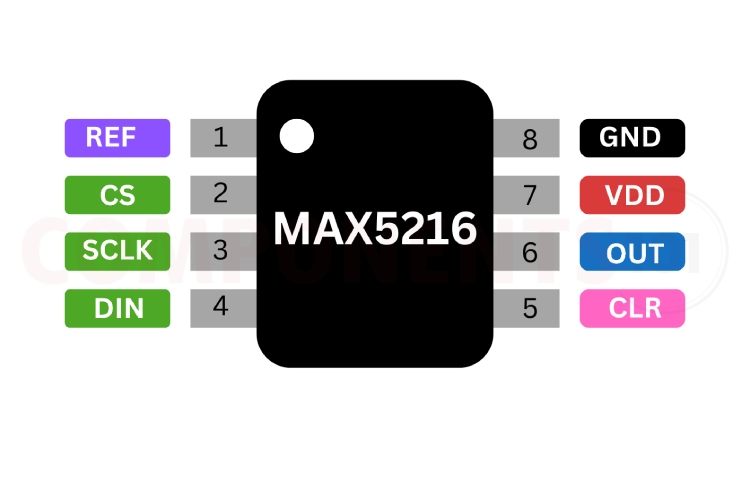MAX5216 16-Bit, Low-Power, Buffered Output, Rail-to-Rail DAC
The MAX5216 is a 16-bit single-channel, low-power, buffered voltage-output digital-to-analog converter (DAC). The MAX5216 accept a wide 2.7V to 5.5V supply voltage range. Power consumption is extremely low to accommodate most low-power and low-voltage applications. The DAC features an internal precision reference this approach helps achieve rail-to-rail operation and low system power consumption by utilizing the precision of the external reference while minimizing current flow through the reference input. This device features a 3-wire SPI, QSPI, MICROWIRE, and DSP-compatible serial interface to save board space and reduce the complexity of isolated applications. The MAX5216 includes features to minimize digital noise feedthrough from the input to the output. One of these features is the powering down of the SCLK and DIN input buffers after the completion of each serial input frame. This helps reduce noise coupling from the digital inputs to the analog output, ensuring that the output remains stable and free from interference. The MAX5216 is available in an ultra-small (3mm x 5mm), 8-pin µMAX package.
MAX5216 Pinout Configuration
Here are the pinout details for MAX5216.
| Pin Number | Name | Function |
| 1 | REF | Reference Voltage Input. |
| 2 | CS | Active-Low Chip-Select Input |
| 3 | SCLK | Serial-Clock Input Serial-Clock Input |
| 4 | DIN | Data in |
| 5 | CLR | Active-Low Asynchronous Digital-Clear Input. |
| 6 | OUT | Buffered DAC Voltage Output |
| 7 | VDD | Supply Voltage |
| 8 | GN | Ground |
Features of MAX5216
MAX5216 ADC chip has the following key features:
- Low Power Consumption (80µA max)
- 16-Bit Resolution in a 3mm x 5mm, 8-Pin μMAX Package
- Relative Accuracy
- ±1.2 LSB INL (MAX5216, 16-Bit type, ±4 LSB max)
- Guaranteed Monotonic overall operating ranges
- Low Gain and Offset Error
- Wide 2.7V to 5.5V Supply Range
- Rail-to-Rail Buffered Output Operation
- Safe Power-On Reset (POR) to Zero DAC Output
- Fast 50MHz, 3-Wire, SPI/QSPI/MICROWIRE Compatible Serial Interface
- Schmitt-Trigger Inputs for Direct Optocoupler Interface
- Asynchronous CLR Clears DAC Output to 0
- High Reference Input Resistance for Power Reduction
- Buffered Voltage Output Directly Drives 10kΩ Loads
Manufacturers of MAX5216:
The MAX5216 is manufactured by Analog Devices (earlier this IC was from Maxim Integrated). There are no alternative manufacturers for the same part number as of the date of writing this article.
MAX5216 Equivalents
If you are looking for an equivalent replacement for MAX5216, you can use MAX5214 from the same family, which is a 14-bit DAC.
MAX5216 Alternatives
If you are looking for an alternative for MAX5216 you can look at the other IC from these.
DAC8562, MCP4725, MCP4921, PT8211, DAC0832, DAC0808, DAC7715, AD5737, AD5421.
Note: Complete technical details can be found in the MAX5216 datasheet at this page’s end.
MAX5216 Typical Circuit Diagram

The above diagram shows a typical connection diagram of max5216 with a microcontroller. The SPI pins are connected to the SPI pins of DAC to establish communication. we have added a 100pf,100nf,4.7uf decoupling capacitors to minimize the noise and stabilize the circuit. In the circuit, we used max6029 to provide a stable reference voltage.
MAX5216 Troubleshooting Guide
My MAX5216 is not providing any output. What could be the issue?
First, ensure that the power supply voltages are within the specified range (2.7V to 5.5V). Check the connections to the MAX5216, including VDD, GND, and the reference voltage.
My circuits show a lot of noise, how to reduce it?
Should use bypass capacitors in between VDD and GND. Use a solid ground plane and connect it directly to the DAC's ground pin. Avoid ground loops and minimize the length of high-current ground paths.
Does the MAX5216 interfere with EMF signals?
Yes, the MAX5216 will interfere with EMF lines so Consider using shielding techniques to protect the DAC from external electromagnetic interference.
How to do MAX5216 Arduino interfacing?
The MAX5216 uses a standard SPI protocol for communication. So, you can use the SPI bus available in the Arduino to communicate with the MAX5216. More details about the SPI communication can be found in the datasheet.
Things to Consider When Using MAX5216 in Your Design
When designing with the MAX5216, a 16-bit Analog-to-Digital Converter (ADC), here are some important considerations and design tips to keep in mind:
Layout Guidelines
Digital and AC transient signals on GND can create noise at the output. Connect GND to the star ground for the DAC system. Refer the remote DAC loads to this system ground for the best possible performance. Use proper grounding techniques, such as a multilayer board with a low-inductance ground plane, or star connect all ground return paths back to the MAX5216 GND. Carefully lay out the traces between channels to reduce AC cross-coupling. Do not use wire-wrapped boards and sockets. Use shielding to improve noise immunity. Do not run analog and digital signals parallel to one another, especially clock signals. Avoid routing digital lines underneath the MAX5216 package.
Power Supply Recommendations
Bypass VDD with high-quality 0.1µF ceramic capacitors to a low-impedance ground as close as possible to the device. Minimize lead lengths to reduce lead inductance. Connect the GND to the analog ground plane.
Applications of MAX5216
- 2-Wire Sensors
- Automatic Test Equipment
- Automatic Tuning
- Communication Systems
- Gain and Offset Adjustment
- Portable Instrumentation
- Power Amplifier Control
- Process Control and Servo Loops
- Programmable Voltage and Current Sources
How to order MAX5216
The MAX5216 is available in two-part numbers, MAX5216GUA+ and MAX5216BGUA+. The MAX5216GUA+ offers ±4 LSB Integral Nonlinearity while the MAX5216BGUA+ offers ±8 LSB Integral Nonlinearity.
MAX5216 Footprint Information
Here you can find the mechanical drawings of MAX5216 along with its dimensions. The dimensions can be used to create custom footprints of the module and be used for PCB or CAD modelling.












